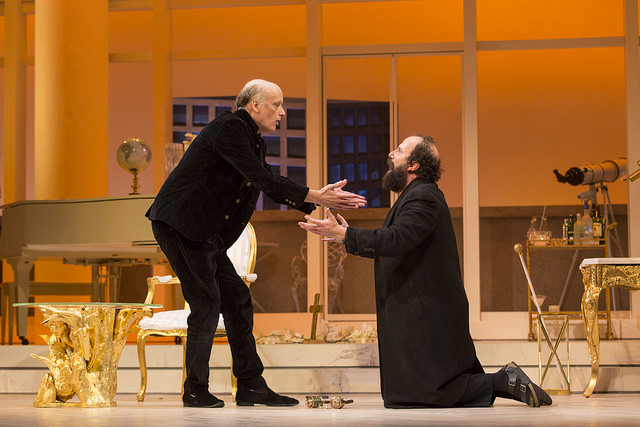 |
| The Cast of "Sense & Sensibility" (photo: Ashley Garrett) |
As the Bedlam company enters in contemporary dress, they
gradually put on period attire that transforms them, as Austen's
world begins to take shape before our very eyes, morphing into the
world of late eighteenth century England. The story takes place over
a five year period, from 1792 to 1797, in southwest England, London
and Sussex, beginning with the death of old John Dashwood (Benjamin
Russell), leaving his widow Mrs. Dashwood (Lisa Birnbaum) and their
three daughters: their eldest daughter, most sensible, Elinor (Maggie
Adams McDowell); their middle daughter, romantic Marianne (Jessica
Frey); and their youngest daughter, impressionable Margaret (Violeta
Picayo). Their relationships with their suitors, unassuming Edward &
Robert Ferrars (both played by Jamie Smithson), the unscrupulous John
Willoughby (Russell again), and the loyal Colonel Brandon (James
Patrick Nelson), ensure that before the story is over, there will be
pledges of love as well as broken hearts. As the title indicates,
there are significant approaches to life identifiable as “sense”
(referring to prudence and good judgment, as in the case of Elinor),
or “sensibility” (meaning emotionality and sensitivity,
demonstrated by Marianne). Also involved are Mrs. Jennings (Nigel
Gore), John Middleton (Ryan Quinn), Fanny/Lucy Steel (Katie Hartke)
and Anne Steele/Mrs. Ferrars (Birnbaum again). The basic story (or,
rather, stories) are well enough known from the novel as well as the
numerous television and film adaptations, but this version by Bedlam
(as is their wont) is a real trip like no other. And every single
member of this tenfold ensemble is brilliant. As just one example,
in the blink of an eye Birnbaum flashes from motherly concern as Mrs.
Dashwood to airhead Anne Steele to ancient Mrs. Ferrars with
lightning speed in a bravura display.
 |
| The Cast of "Sense & Sensibility" (photo: Ashley Garrett) |
Along the way, there are more than a few Austenian wry nuggets. The novelist rather benignly wound down in a similar manner in which she had begun, with the statement that “though sisters, and living almost within sight of each other, they could live without disagreement between themselves, or producing coolness between their husbands”. Yet in its truthful depiction of the fate of single or widowed women with no means or station, there is a somber undertow to the play, but if one can accept that the siblings end up with men not of their dreams, it's an undeniably merry romp. Thanks in large part to the precision provided by the creative team, led by Tucker with his inexhaustible bag of tricks, all's well that ends well, though not, as noted, as its lead characters would have planned it. The (literally) fluid Scenic Design on wheels by John McDermott, complex Lighting Design by Les Dickert, witty Costume Design by Angela Huff and effective Sound Design by Alex Neumann all contribute to this polished and professional frolic. It's absolutely breathtaking.
This production will be presented through January 14th,
and Bedlam will be returning to Boston in March to ArtsEmerson to
display their more serious side with their double bill of Hamlet
and St. Joan (the latter fondly remembered from its
production at Central Square Theatre a few seasons ago). Meanwhile,
one may revel in the superficial silliness at hand. At the same time a member of an audience entertained by
this show will be all the better for experiencing those broken hearts
and troth pledgings, for, as Marianne challenges Elinor (and Austen
challenges her readers): “do not ask me not to feel”.
























